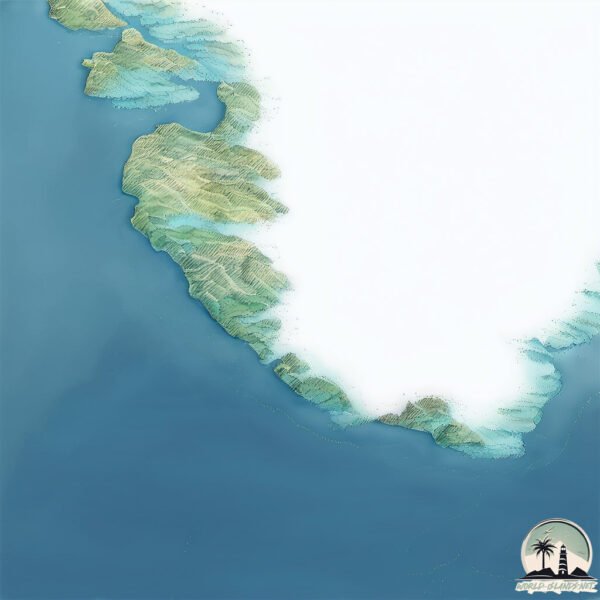Nunarsuaq

Welcome to Nunarsuaq, a Polar island in the Davis Strait, part of the majestic Arctic Ocean. This guide offers a comprehensive overview of what makes Nunarsuaq unique – from its geography and climate to its population, infrastructure, and beyond. Dive into the details:
- Geography and Size: Explore the island’s size and location.
- Climate and Weather: Weather patterns and temperature.
- Topography and Nature: Uncover the natural wonders of the island.
- Infrastructure and Travelling: Insights on reaching, staying, and making the most of your visit.
- News and Headlines: Latest News.
Geography and size of Nunarsuaq
Size: 11.9 km²
Coastline: 28.8 km
Ocean: Arctic Ocean
Sea: Davis Strait
Continent: North America
Nunarsuaq is a Medium Island spanning 12 km² with a coastline of 29 km.
Archipel: –
Tectonic Plate: North America – Covers North America and parts of the Atlantic and Arctic Oceans, characterized by diverse geological features and varying levels of seismic activity.
The geographic heart of the island is pinpointed at these coordinates:
Latitude: 64.3295142 / Longitude: -49.94861242
Climate and weather of Nunarsuaq
Climate Zone: Polar
Climate Details: Tundra
Temperature: Cold
Climate Characteristics: The tundra climate features long, extremely cold winters and short, cool summers. Vegetation is limited to mosses, lichens, and small shrubs due to the low temperatures and short growing seasons. Biodiversity is low, but some specialized species thrive.
Topography and nature of Nunarsuaq
Timezone: UTC-03:00
Timezone places: America/Sao_Paulo
Max. Elevation: 861 m
Mean Elevation: 190 m
Vegetation: Herbaceous Cover
Tree Coverage: 32%
The mean elevation is 190 m. The highest elevation on the island reaches approximately 861 meters above sea level. The island is characterized by Plateau: Elevated flatlands rising sharply above the surrounding area, with a maximum elevation over 500 meters but a mean elevation less than 300 meters, forming unique highland areas on islands.
Dominating Vegetation: Herbaceous Cover
Comprising mainly of grasses, herbs, and ferns, these areas are common in prairies, meadows, and savannas, and can vary widely in species composition. Nunarsuaq has a tree cover of 32 %.
Vegetation: 5 vegetation zones – Highly Diverse Island
With five different vegetation zones, these islands offer a rich tapestry of ecosystems. The variety could include dense forests, open meadows, wetlands, coastal zones, and more. This level of diversity supports an intricate web of life, with each zone playing a vital role in the overall ecological health and balance of the island.
Infrastructure and Travelling to Nunarsuaq
Does the island have a public airport? no.
There is no public and scheduled airport on Nunarsuaq. The nearest airport is Narsarmijit Heliport, located 7 km away.
Does the island have a major port? no.
There are no major ports on Nunarsuaq. The closest major port is ATTU, approximately 5 km away.
The mean population of Nunarsuaq is 0 per km². Nunarsuaq is Uninhabited. The island belongs to Greenland.
The name of the island resonates across different cultures and languages. Here is how it is known around the world: Arabic: جزيرة غرينلاند; German: Grönland; Spanish: Groenlandia; French: Groenland; Portuguese: Groenlândia; Russian: Гренландия; Chinese: 格陵兰岛
Continuing your journey, Tuttulik is the next notable island, situated merely km away.
Nunarsuarmut qaamaneq - Copyright Baha'i World Center



Greenland is classified as Developed region: nonG7: Developed economies outside of the Group of Seven, characterized by high income and advanced economic structures. The level of income is High income: OECD.
News – Latest Updates and Headlines from Nunarsuaq
Stay informed with the most recent news and important headlines from Nunarsuaq. Here’s a roundup of the latest developments.
Please note: The data used here has been primarily extracted from satellite readings. Deviations from exact values may occur, particularly regarding the height of elevations and population density. Land area and coastline measurements refer to average values at mean high tide.
